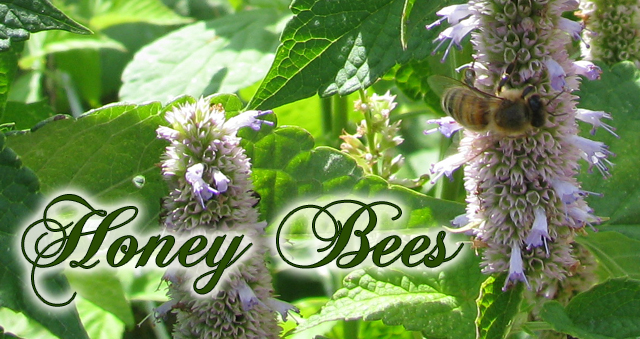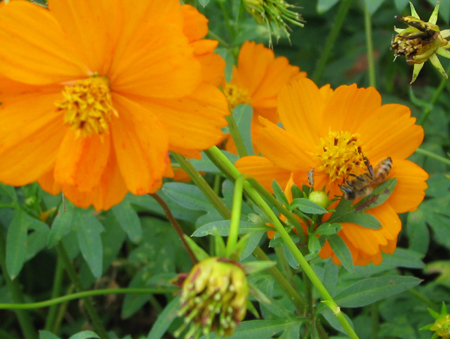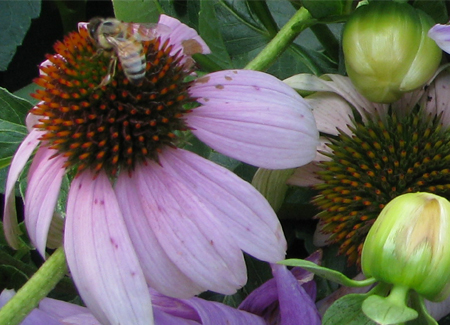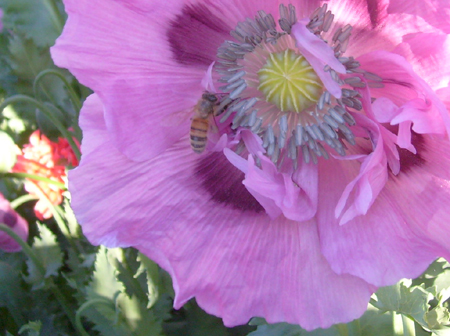
About Bees
Many flowers and plants are cultivated on at Honeymoon Bee Farm just to encourage and nourish our bees.
- The honey bee has been around for millions of years.
- Honey bees, scientifically also known as Apis mellifera, are environmentally friendly and are vital as pollinators.
- It is the only insect that produces food eaten by man.
- Honey is the only food that includes all the substances necessary to sustain life, including enzymes, vitamins, minerals, and water; and it's the only food that contains "pinocembrin", an antioxidant associated with improved brain functioning.
- Honey bees have 6 legs, 2 compound eyes made up of thousands of tiny lenses (one on each side of the head), 3 simple eyes on the top of the head, 2 pairs of wings, a nectar pouch, and a stomach.
- Honey bees have 170 odorant receptors, compared with only 62 in fruit flies and 79 in mosquitoes. Their exceptional olfactory abilities include kin recognition signals, social communication within the hive, and odor recognition for finding food. Their sense of smell was so precise that it could differentiate hundreds of different floral varieties and tell whether a flower carried pollen or nectar from meters away.
- The honey bee's wings stroke incredibly fast, about 200 beats per second, thus making their famous, distinctive buzz. A honey bee can fly for up to six miles, and as fast as 15 miles per hour.
- The average worker bee produces about 1/12th teaspoon of honey in her lifetime.
- A hive of bees will fly 90,000 miles, the equivalent of three orbits around the earth to collect 1 kg of honey.
- It takes one ounce of honey to fuel a beeís flight around the world.
- A honey bee visits 50 to 100 flowers during a collection trip.
- The bee's brain is oval in shape and only about the size of a sesame seed, yet it has remarkable capacity to learn and remember things and is able to make complex calculations on distance traveled and foraging efficiency.
- A colony of bees consists of 20,000-60,000 honeybees and one queen. Worker honey bees are female, live for about 6 weeks in the summer and do all the work.
- The queen bee can live up to 5 years and is the only bee that lays eggs. She is the busiest in the summer months, when the hive needs to be at its maximum strength, and lays up to 2500 eggs per day.
- Larger than the worker bees, the male honey bees (also called drones), have no stinger and do no work at all. All they do is mating.
- Each honey bee colony has a unique odor for membersí identification.
- Only worker bees sting, and only if they feel threatened and they die once they sting. Queens have a stinger, but they donít leave the hive to help defend it.
- It is estimated that 1100 honey bee stings are required to be fatal.
- Honey bees communicate with one another by "dancing".
- During winter, honey bees feed on the honey they collected during the warmer months. They form a tight cluster in their hive to keep the queen and themselves warm.
The more I learn about honey bee facts; honey's great creator - the honey bee itself, its highly organized society, how it acts with such intricate cooperation, and the various bee products, the more I admire and respect this amazing creature. It is no wonder why sometimes the colony is called a super-organism.
If the bee disappears from the surface of the earth, man would have no more than four years to live. ~ Albert Einstein (credited)




Unique among all God's creatures, only the honeybee improves the environment and preys not on any other species.
Our Honey
Honey is a genuine food in its original state and is as recognizable to us as it was to early civilizations. Honey is probably the last remaining vestige of a bygone era where you could buy real food. This is as raw, pure, unprocessed, as natural as it gets. Our honey is the farthest thing from the honey sold at supermarkets or Wal-Marts. That is the caramelized syrup manufactured by huge food companies for uniform flavor, color and profit margin. It never crystallizes, it never have air bubbles or flecks of pollen it in. It is always called clover honey because some executive somewhere hijacked the word and redefined it to mean manufactured, cooked honey, origins unknown. It has nutrition labels and bar codes and all exactly the same.
Our honey on the other hand tastes different from season to season, even in the same year. And the color of our honey also changes depending on the weather, rainfall, what is blooming and what the bees prefer to collect. Our labor as beekeepers, and the resulting honey is truly one of the last artisanal foods. It cannot be mass-produced. In fact our honeybees make a very limited supply of honey each year, and when it ran out, we have to wait until the next honey flow and harvest season, hoping for kind weather and healthy bees.
Pure raw honey will store indefinitely, it never goes bad since bacteria cannot live in it. It will crystallize, it can be returned to the liquid state by warming the bottle in hot water or microwave (only takes seconds, be careful not to overheat in microwave) without affecting the quality of the honey.
Honey's Nutritional Profile
The antibacterial properties of honey may help clear infection in wounds, and the anti-inflammatory action of honey may reduce pain and may improve circulation which hastens the healing process. Honey stimulates the re-growth of tissue involved making healing faster and reducing scarring.
Honey has a phytochemical profile which includes polyphenols that can act as antioxidants.
The antioxidants in honey, called polyphenols, are similar to those found in fruits, vegetables and olive oil. Polyphenols are thought to reduce the risk of many diseases by disarming disease-causing free radicals in the body.
While honey's antibiotic properties help promote faster wound healing, its antifungal properties can provide relief for many common skin conditions, including ringworm, athlete's foot and yeast infections. As a fungus-fighter, honey appears to be comparable to many over-the-counter antifungal preparations.
Honey contains small amounts of a wide array of vitamins, minerals, amino acids and antioxidants. The vitamins found in honey may include (depending on floral variety) niacin, riboflavin and pantothenic acid; minerals present include calcium, copper, iron, magnesium, manganese, phosphorus, potassium and zinc. Just as the color and flavor of honey varies by floral source, so does the vitamin, mineral, antioxidant and amino acid content.
Honey is a great source of energy, one tablespoon supplies 64 calories providing quick and efficient fuel to working muscles.
Honey has a healthy Glycemic Index (GI), meaning that its sugars can be gradually absorbed into the bloodstream to result in better digestion. We should try to avoid eating excessive high-glycemic foods which would prompt an elevated insulin release in our body as a result of the pancreas being stimulated to metabolized the sudden surge of glucose into the blood.
Honey contains natural minerals and vitamins which help the metabolizing of undesirable cholesterol and fatty acid on the organs and tissues into the system, hence preventing obesity and promoting better health for us.
Honey is a monosaccharide, the simplest form of sugar that cannot be further broken down, passing directly from the small intestine into the blood stream without causing any irritancy to our digestive system as sucrose does.